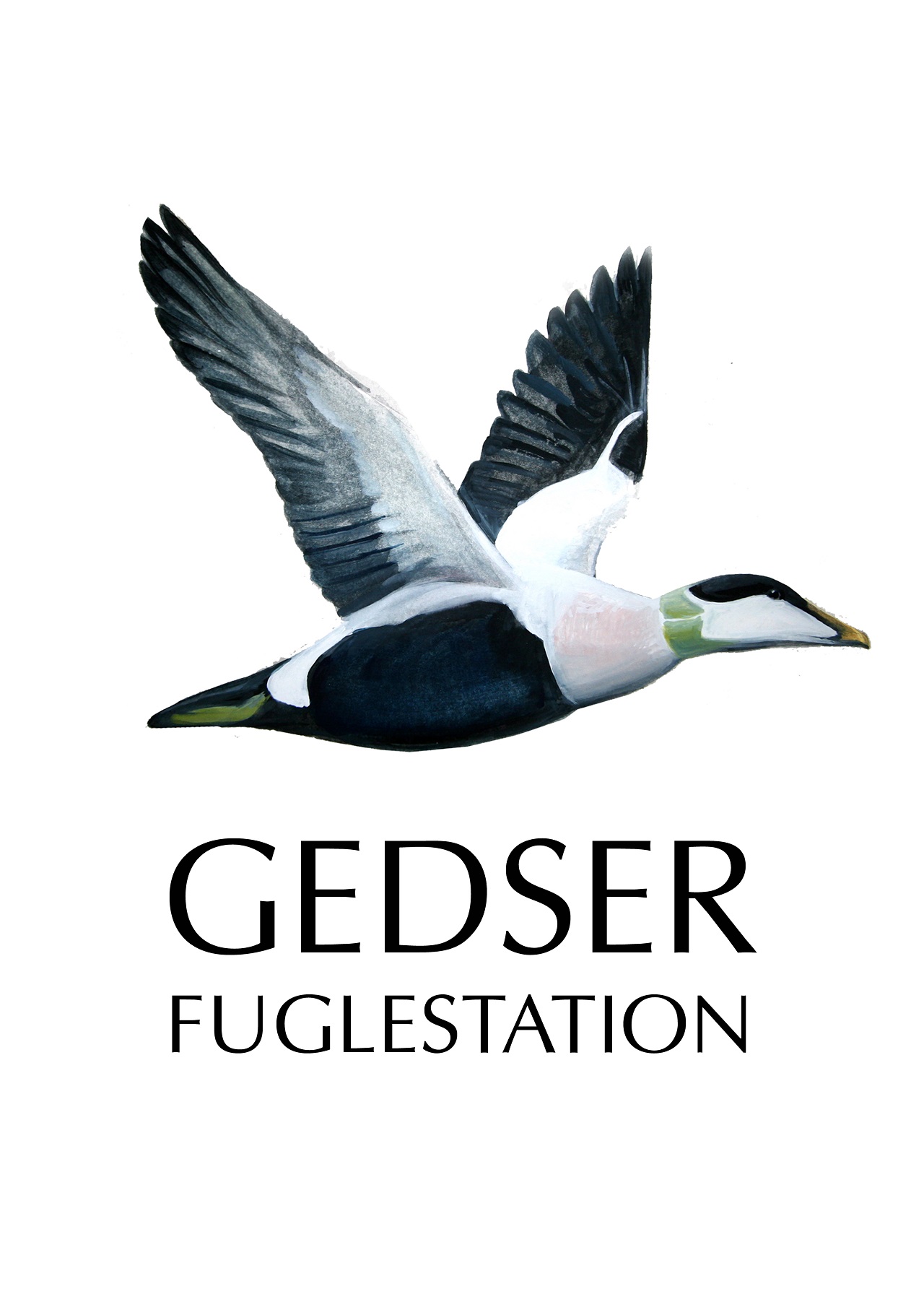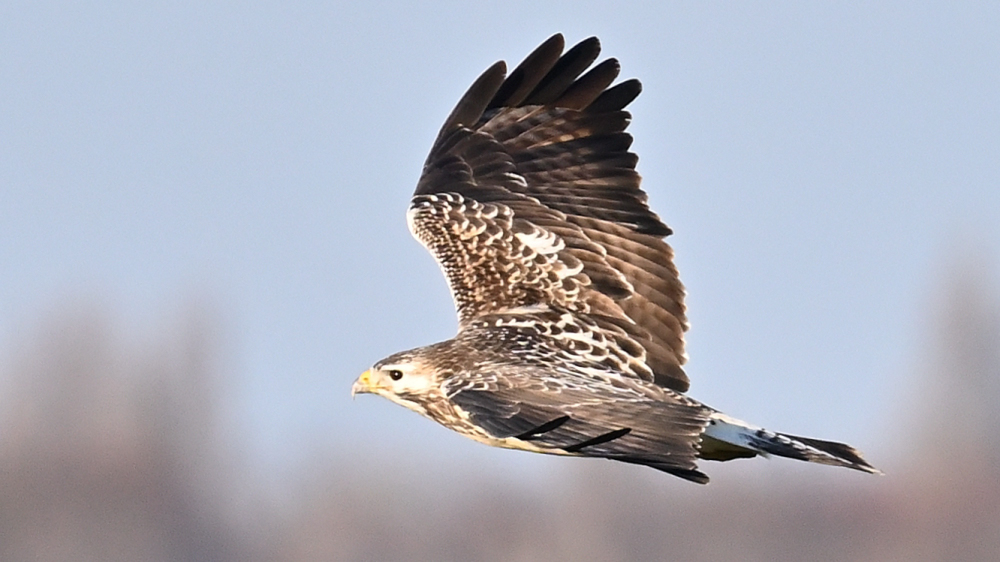Gedser Fuglestation Blog
Her på Gedser Fuglestations blog bringes korte nyheder i dagbogsformat om hændelser på fuglestationen.
Tyveri på fuglestationen
Ringmærkningen: I dag kommer der kun blog om ringmærkning da observatøren var til møde.
Det var helt vindstille til at starte med så et ekstra net (nærmeste hejsenet) kom op, vinden tog dog til over formiddagen og efter middag lå den på 9,8 m/s.
Dagen blev faktisk rigtig god med 11 fugle hvoraf de 9 var nye.
Da nettene skulle op manglede noget ved spurvehøgenettet, kyllingen var blevet stjålet i nattens løb, så nu er der en mæt ræv et sted. Heldigvis havde jeg en reservekylling så den kom ud og den blev sikret da nettene blev lukket så ræven ikke tager den også.
Vejret fra i morgen ser rigtigt skidt ud med en del regn, så jeg tager nok på Odden og hjælper med at tælle træk hvis det bliver skidt vejr.
Dagens ringmærkning og kontroller/Todays ringing and recaptures:
Gærdesmutte/Wren 1
Solsort/Blackbird 1(2)
Kvækerfinke/Brambling 1
Stillits/Goldfinch 3
Grønsisken/Siskin 3
Total 9(2)
På stationen: Ole Friis Larsen, Henrik Jørgensen
Fint træk af Gråænder
Ringmærkningen: Udsigten for de første timer var god ifølge prognose og radar, men det var ikke sådan det var.
Det dryppede da nettene skulle op, men kun så lidt at de sagtens kunne komme op. Det ændrede sig dog og det begyndte at småregne så jeg gik oftere da der stadig intet var at se på radaren. Da jeg så ville lukke pga regn lysnede det pludselig og nettene kunne forblive åbne indtil 12.15, dog dryppede det flere gange.
Det blev dog heldigvis ikke en nul-dag, så det var kampen værd.
Vejret for i morgen ser ganske godt ud, der loves hverken regn eller meget vind.
Dagens ringmærkning og kontroller/Todays ringing and recapture:
Solsort/Blackbird 1(1)
Stillits/Goldfinch 2
Total 3(1)
Trækket på Odden: Kan man tælle fugletræk helt neutralt og fri for forudsætninger? Nej, det kan man nok ikke. De fleste af os tager formentlig af sted med forventninger om et eller andet bestemt i forhold til årstiden, vejrprognosen, og hvad der er noteret i DOFbasen de seneste dage forinden. Man kan måske alligevel opnå noget ved at forsøge at være så forudsætningsløs som muligt; tage af sted uden at skele mere til vejret, end om man skal have mere eller mindre varmt tøj på end dagen før, og sige til sig selv, at det er selve trækket, der er interessant og vigtigt, mere end bestemte ’target-arter’ eller rekordtal.
De fleste bruger efterhånden den hollandske database Trektellen, som er den hurtigste at bruge på mobiltelefonen, uden at kigge på tallene undervejs i dagens tælling, for ikke at blive præget af lige at ’mangle’ fire mere af en given art for at nå et eller andet bestemt tal.
Der er meget at arbejde med som træktæller for en fuglestation.
Tirsdagens fem timer kom til at foregå i regn og støvregn med vind fra nordøst, som kun giver få muligheder for læ og ly ved den gamle marinestation. Inde under halvtaget er udsynet begrænset, men det var området at tælle i også, fordi regndisen ind imellem begrænsede udsynet til nogle få hundrede meter. Alligevel blev det en bemærkelsesværdig og fin dag med lige over 1.900 fugle fordelt på 23 arter.
Fem Suler (Morus bassanus) er stadig noget særligt ved Gedser Odde. Det samme gælder dagens træk af 257 Gråænder (Anas platyrhynchos), som er det næsthøjeste antal i standardtiden i den tid, vi har lavet træktællinger for Gedser Fuglestation, kun overgået af 317 14. november 2022. Også det samlede antal Gråænder i dette efterår er indtil nu det næsthøjeste med 2.128, og det er ikke langt fra den hidtidige rekord på 2.239 i 2022. Tirsdagens våde og disede formiddag var bestemt en stor dag, når vi taler om Gråænder.

Andre nævneværdige ryk i tirsdagstrafikken over havet var en ung Ride (Rissa tridactyla) i en flok Hættemåger (Croicocephalus ridibundus), ligesom 215 Rødstrubede Lommer (Gavia stellata) var et fint tal, selv om det er langt fra at være nogen rekord.
Torsdag bliver der hverken talt træk på Odden eller skrevet blog om trækket på grund af andet fuglearbejde.
Se alle dagens observationer fra Gedser Odde i DOFbasen.
Folk på stationen: Henrik Jørgensen, Ole Friis Larsen.
Her dækker vi trækket af lommer
Ringmærkningen: Et kig på vejret for dagen sagde tørvejr på DMI, men den holdt ikke stik da der klokken 8 begyndte at småregne og 20 minutter efter begyndte det at regne rigtigt så der lukkede jeg ned for dagen.
Det småregnede stadig klokken 9 så jeg valgte at kaste håndklædet i ringen for i dag og gik ud på Odden og hjalp med at tælle trækket.
Vejret for i morgen er ret usikkert, så det er ikke helt til at vide.
Hans kom ud ved middag da der skal laves lidt ændringer på rovfuglefælden.
Trækket på Odden: Et blik på den hollandske, men internationalt brugte fugledatabase Trektellen tyder på, at der er lukket og slukket for det daglige tælleri på alle andre nordeuropæiske lokaliteter, og der er ikke meget tilbage at tælle, men det gør det ikke mindre interessant og lærerigt, og på Gedser Fuglestation bliver vi ved til 20. december. Trækket af lommer foregår meget sent og topper først her i første del af december, og da vi begyndte på daglige træktællinger for allerede en del år siden, var der folk, som insisterede på, at vi skulle have trækket af lommer med i vores systematiske program.
Derfor var der også folk fra fuglestationen på plads i mørket – og regnen – en halv time før solopgang denne tirsdag. Heldigvis var det mildt med en temperatur omkring 7 grader og let at finde læ for den aftagende vind fra sydvest. Desuden var der pænt træk af lommer og masser af udfordring i at bestemme dem, fordi de fløj langt ude, hvor de var svære at se i disen.
Dagens samlede tal blev ikke stort, fordi trækket af Ederfugle (Somateria mollissima) næsten er stoppet, og lodsbådenes trafik gennem flokkene af rastende fugle samtidig gør det svært at skelne mellem reelt træk og opflyvende rastefugle. I alt blev det til lidt over tusind fugle på træk fordelt på 25 arter, hvoraf 190 var deltagere i det interessante træk af Rødstrubede Lommer (Gavia stellata) ud af Østersøen.
Dagens største lyspunkt var en Tejst (Cepphus grylle), fordi arten er ret sjælden ved Gedser Odde. Den overvejende lyse alkefugl var enten en adult/voksen i vinterdragt eller en ung fugl i sin første vinterdragt. Den rastede kort på vandet, før den fløj videre mod sydvest, men den var langt ude og ikke til at se detaljer på med sikkerhed, før den var væk.
Se alle dagens observationer fra Gedser Odde i DOFbasen.
Folk på stationen: Hans Lind, Henrik Jørgensen, Ole Friis Larsen.
Tegn på varige spor af fugleinfluenza
Ringmærkningen: Igen var vinden ikke den bedste for fangst og det kunne også ses både på fangst og i hele haven, faktisk så jeg kun 2 solsorte(og en blev fanget).
Trods en masse tomme runder fik jeg ordnet lidt småting på stationen mellem runderne.
Hans kom ud efter middag og rovfuglefælden blev ordnet og sat ud så nu kan der fanges 2 steder både i haven og ude på engen.
I morgen tidlig er der risiko for regn, men forhåbenligt holder det tørt de første timer, ellers tager jeg ud og hjælper Ole med trækket.
Dagens ringmærkning/Todays ringing:
Solsort/Blackbird 1
Trækket på Odden: En overskyet og forblæst dag med dis og nedsat sigtbarhed. Vinden kom fra sydvest, og fra land var der overhovedet kun en enkelt lille flok Engpibere (Anthus pratensis) at se på ruten ud over vandet mod syd. På havet var der et pænt morgenryk af Ederfugle (Somateria mollissima), lommer og andre havfugle, men det varede kun en times tid, hvorefter trafikken var beskeden. Det gav tid til at kigge på måger. Især Stormmågerne (Larus canus) er interessant nu med chancer for at se den russiske underart heinei, men det blev ved træningen i mere almindelige versioner.
’Dagens Sule’ (Morus bassanus) viste sig først sent på formiddagen, men den kom relativt tæt forbi, og det var smukt. Den kom dog ikke tæt nok på til, at det var til at se øjenfarven, som er interessant efter den store epidemi af fugleinfluenza i 2021 og 2022.
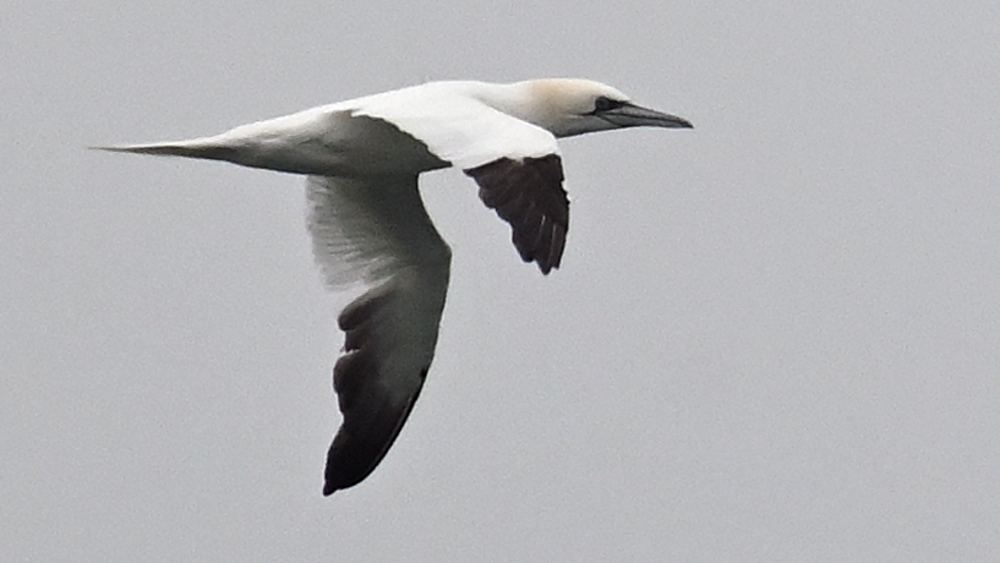
Britiske forskere har taget blodprøver på 19 Suler på Bass Rock ud for østkysten af Skotland. Øen har verdens største ynglekoloni af Suler, og Sulerne ved Gedser Odde kan meget vel komme derfra. Otte af blodprøverne var positive for fugleinfluenza som tegn på, at Sulerne havde overlevet den dødbringende sygdom, og samtidig fandt forskerne, at syv af de otte Suler, som havde overlevet at blive smittet, havde sorte øjne i stedet for den blege blågrå farve, som iris i Sulernes øjne normalt har. Forskerne fandt også sorte øjne hos et par af de Suler, der testede negativt for fugleinfluenza, men det var alligevel påfaldende, at syv af de otte overlevere havde sorte øjne. Læs en videnskabelig artikel på engelsk om fugleinfluenza og sorte øjne på Suler her eller en mere populær artikel her.
Derfor vil vi nok prøve at kigge efter øjenfarven igen, næste gang der kommer Suler forbi Gedser Odde. De næsten daglige forekomster er alle adulte/voksne fugle eller næsten voksne fugle, så det er Suler, der har oplevet fugleinfluenzaen i 2021 og 2022. Enten har de været heldige ikke at blive smittet, eller de har overlevet sygdommen.
Tak til Louis A. Hansen for links til de to artikler om Sulerne.
Se alle dagens observationer fra Gedser Odde i DOFbasen.
Folk på stationen: Hans Lind, Henrik Jørgensen, Ole Friis Larsen.
Et ekstra tjek af en Musvåge
Ringmærkningen: Vinden lå godt på nettene i dag så der var ikke nogen problemer, men solen stod fra en skyfri himmel.
På trods af solen blev der fanget indtil næsten middag, og 13.45 lukkede jeg ned da der i 2 timer ikke var gået noget i.
En adult spurvehøg røg i nettet hvor der blev afspillet lyd, men den røg hurtigt ud igen.
Det blev en ganske god dag hvoraf de 8 blev fanget på lyd på de 60 meter net som var oppe.
Dagens ringmærkning/Todays ringing:
Grønirisk/Greenfinch 2
Grønsisken/Siskin 8
Total 10
Trækket på Odden: Den første dag i december bød på en blændende smuk solopgang og godt selskab, idet vi var tre fra start til slut om dagens tælling – og oplevelser. Det kommer tid til at handle om tal, men arbejdet med tallene handler selvfølgelig også om udfordringer at blive klogere af og fine oplevelser af fugle.
Denne søndag var der fine tal med over 130 af de sorte Fløjlsænder (Melanitta fusca) med deres kridhvide felter på vingerne, over 350 Bjergænder (Aythya marila), som først kommer forbi i større flokke her i sidste del af efterårstrækket ud af Østersøen. Over 180 Rødstrubede Lommer (Gavia stellata) og 11 Sortstrubede Lommer (Gavia arctica) var heller ikke dårligt på en dag med meget solskin, som får havtrækket til at gå i stå.
Vi talte om, at vi har haft et pænt træk af Sortstrubede Lommer i den seneste tid, selv om antallet aldrig bliver højt.
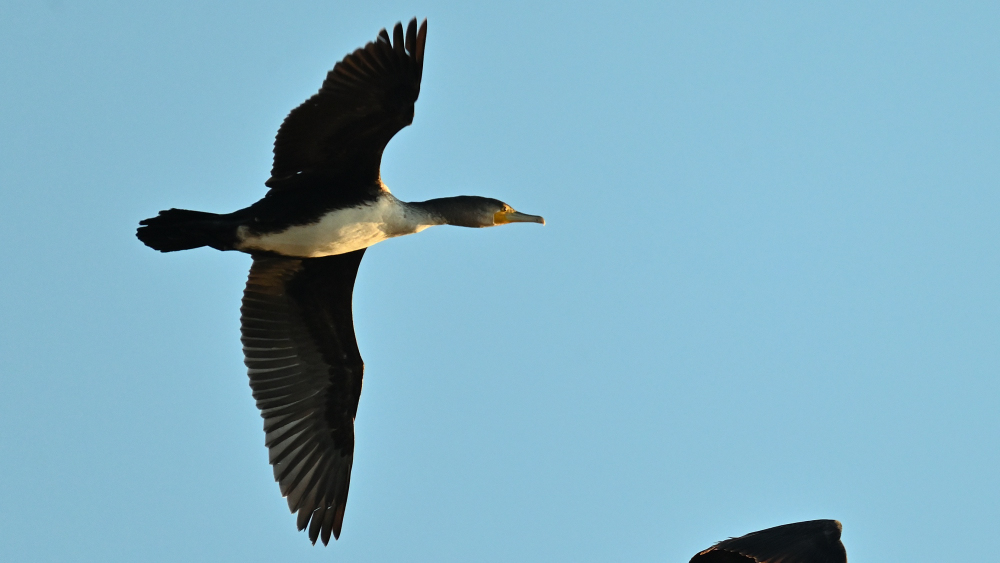
Mest bemærkelsesværdigt denne søndag var imidlertid en flok på 43 Snespurve (Plectrophenax nivalis). Den nordlige småfugl er ikke noget sjældent syn i Danmark om vinteren, men antallet er usædvanlig højt for Gedser Odde. Der er ikke nogen tegn på hård vinter eller andet pres på arten, så det var nok en tilfældighed, at vi så sådan en flok. De kom fra nord langs kystskrænten og fortsatte langs kysten ind mod Gedser.
En del af det sjove ved at opleve fugle er de udfordringer, der giver lyst til at arbejde videre hjemme for at opklare et eller andet. Lørdag havde vi en lys Musvåge (Buteo buteo) med hvide fjerspidser på oversiden på trækforsøg ved Gedser Odde. Vi fik fine billeder af den særegne dragtvariation i dagens solskin. De kom med i dagbogen på Gedser Fuglestations hjemmeside, og ved en sammenkomst inde i Gedser lørdag aften kiggede vi igen på billederne og talte om detaljer i fjerdragten, blandt andet de meget fine bånd på undersiden af vingerne og halefjerene. De lyse spidser på oversiden af vingernes fjer gav os lyst til at spørge andre, om vi nu også havde bestemt Musvågen rigtigt til en adult/voksen fugl.
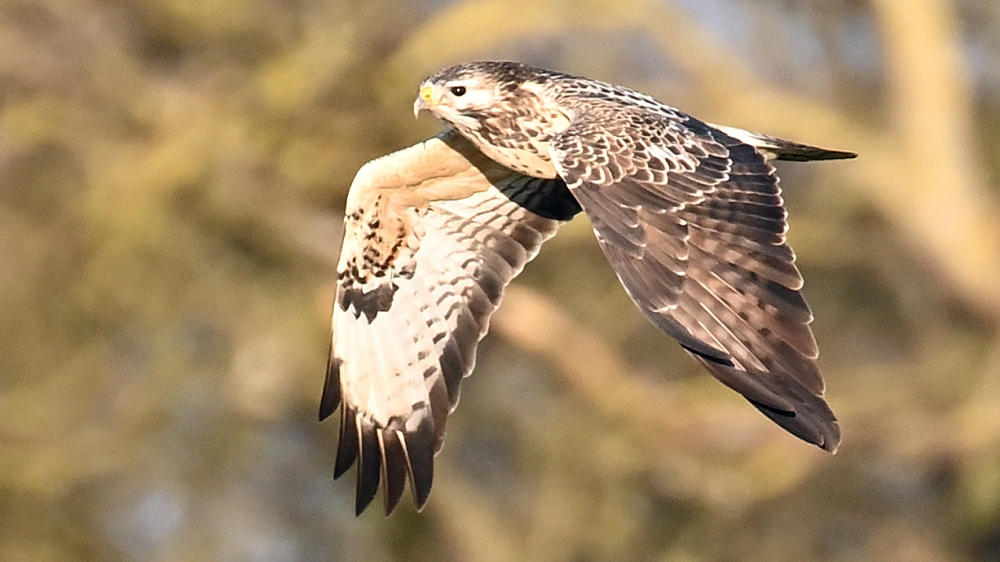
Derfor lagde vi nogle af billederne ind i Facebookgruppen Rovfugle i Felten. Det kan både gøre en selv dygtigere og mere sikker, og det kan være med til, at andre bliver bedre til at bestemme fuglene rigtigt. Der var flere, som var enige i vores aldersbestemmelse til adult/voksen/3k+ (tredje kalenderår eller ældre), så det var helt fint, men det havde selvfølgelig været ligeså interessant og lærerigt, hvis resultatet havde været anderledes.
Se alle dagens observationer fra Gedser Odde i DOFbasen.
Folk på stationen: Henrik Jørgensen, Ole Friis Larsen.
Smuk lys Musvåge i godt solskin
Ringmærkningen: Vinden lå på syd-sydvest på omkring 10 m/s så havens bedste net var lidt udsat og solen gjorde det ikke nemmere.
Der var tomme runder indtil klokken 11 hvor en lille gråsisken var gået i det ene høgenet, så lidt fik vi ud af dagen.
I morgen loves en del mindre vind men sol så det bliver de første par timer som skal give lidt.
Dagens ringmærkning/todays ringing:
Lille gråsisken/Lesser redpoll 1
Trækket på Odden: To dage i godt selskab med andre fuglefolk; kulde og vind er ingen hindring for, at det kan være en fornøjelse at se på fugletræk. Derudover er der ikke meget at fortælle om fredagens træk, som foregik med næsten ingen vind og ideelt overskyet til en stor dag med lommer. Sådan gik det. For fuglestationens observatør endte det med 438 Rødstrubede Lommer (Gavia stellata) og 16 Sortstrubede Lommer (Gavia arctica) i løbet af bare tre en halv time, hvorefter en aftale i København skulle overholdes. En af dagens andre observatører, Preben Berg, holdt ud til 15:45 og talte 1.395 af de rødstrubede og 24 af de sortstrubede.
Lørdag bød også på en fin start med lommer, som hurtigt løb op i et par hundrede, men så kom solen frem, og det får normalt lommerne til at stoppe, så vi endte med 310 rødstrubede og 12 sortstrubede på vej ud af Østersøen. Til gengæld kunne vi glæde os over en opvisning i lodrette styrtdyk af op til fem adulte/voksne Suler (Morus bassanus) på samme tid. Der må være masser af mad ud for Gedser Odde for tiden. Der er 7.000 Ederfugle (Somateria mollissima), 1.050 Sortænder (Melanitta nigra) og andre havænder på havet.
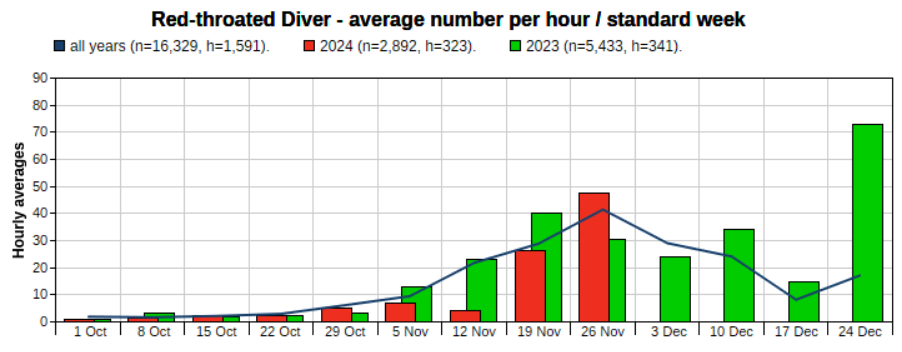 Trækket af Rødstrubede Lommer har ligget lidt lavt i år (røde søjler) i forhold til gennemsnittet (kurven), men til gengæld lidt højere i de seneste dage. Grafikken fra Trektellen viser intensiteten i trækket som fugle per time. Det er det, vi måler ved at tælle fem timer hver dag. De grønne søjler viser sidste års træk, som især i december lå over gennemsnittet.
Trækket af Rødstrubede Lommer har ligget lidt lavt i år (røde søjler) i forhold til gennemsnittet (kurven), men til gengæld lidt højere i de seneste dage. Grafikken fra Trektellen viser intensiteten i trækket som fugle per time. Det er det, vi måler ved at tælle fem timer hver dag. De grønne søjler viser sidste års træk, som især i december lå over gennemsnittet.
De mange rastende ænder gør det sværere at registrere fugle på gennemtræk forbi Odden, fordi rastefuglene ofte er i luften, enten for at flytte sig tilbage, efter at strømmen har ført dem et stykke væk fra, hvor de lå lidt tidligere, eller de flygter fra en af de lodsbåde, der jævnligt sejler gennem området.
Fra land kom der ikke meget nogen af de to dage. Fredag trak et par Musvåger (Buteo buteo) ud over havet. Lørdag kom en Rød Glente (Milvus mulvus) og en Musvåge langt ned mod Odden, men ingen af dem ville ud over vandet i den forholdsvis hårde og kolde modvind fra sydvest.
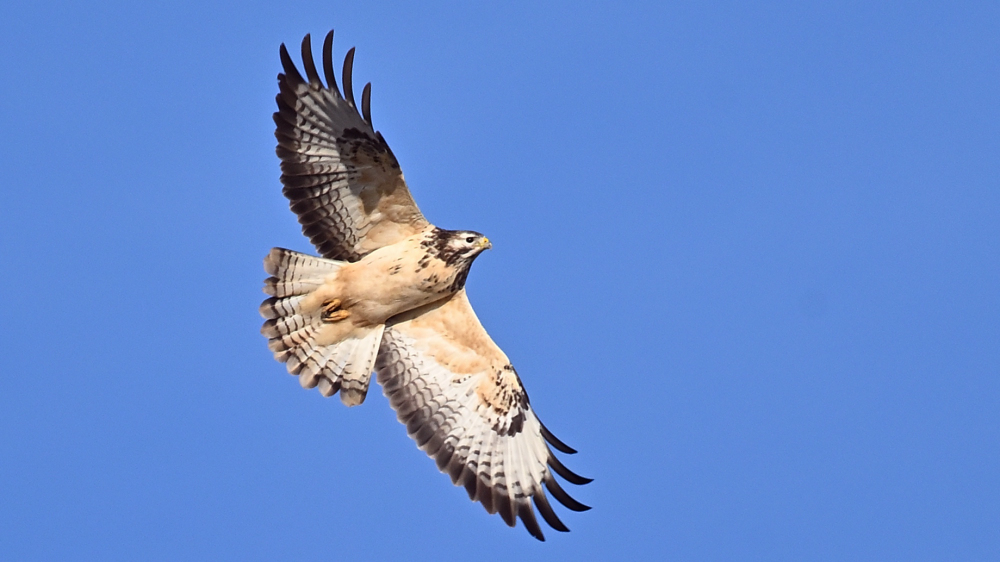
 Trækket af Musvåger har været under gennemsnittet (sort kurve) ved Gedser Odde i september og oktober (røde søjler) og ebber hastigt ud i november. Til sammenligning ses sidste års træk som grønne søjler. Kilde: Trektellen
Trækket af Musvåger har været under gennemsnittet (sort kurve) ved Gedser Odde i september og oktober (røde søjler) og ebber hastigt ud i november. Til sammenligning ses sidste års træk som grønne søjler. Kilde: Trektellen
Se alle lørdagens observationer i DOFbasen.
Folk på stationen: Anne Marie Reith, Henrik Jørgensen, Ole Friis Larsen.
Når lyden virker
Ringmærkningen: Det var næsten vindstille og skyet, så det var det perfekte vejr for fangst.
Kyllingen til rovfuglene var væk til morgen, men jeg tænker at kragerne er fløjet med den smule der var tilbage.
Da sæsonen og den standariserede ringmærkning er slut(15 november) kan jeg både bruge lokkemad og bruge lyd. Pt så bruger jeg lyd til både gråsisken og grønsisken, og i dag fik jeg fanget begge dele. Havde jeg ikke brugt lyd i dag havde jeg kun fanget 2 fugle(rødhals og rørspurv).
I morgen kommer der igen en del vind og så sol. Begge dele gør at nettene bedre kan ses så det bliver nok ikke den "store" dag med mange fugle.
Dagens ringmærkning/Todays ringing:
Rødhals/Robin 1
Stillits/Goldfinch 1
Grønsisken/Siskin 7
Lille gråsisken/Lesser redpoll 1
Rørspurv/Reed bunting 1
Total 11
På stationen:Ole Friis Larsen, Henrik Jørgensen.
Små tal på en regnvejrsdag løber også op
Ringmærkningen: Det havde regnet det meste af natten så nettene måtte rystes for vand, men det var i det mindste tørvejr så alle net kunne sættes op.
Der var dog kun de lokale krager i haven og intet andet som fløj over.
Der blev dog fanget 2 fugle(solsorte), men de var allerede ringmærket. Den ene havde dog en gammel ring på og et tjek viste at den var ringmærket her 6 september 2019, så den var nu 5 år gammel og det er en pæn alder for en solsort!
Nettene måtte lukkes 9.45 da det begyndte at regne, og regnen fortsatte indtil middag.
I morgen falder vinden helt og der kommer ingen regn så det ser godt ud for at kunne holde nettene åbne længere.
Dagens kontroller/Todays recaptures:
Solsort/Blackbird 2
Trækket på Odden: Det bliver en kort beretning på grund af travlhed med andre opgaver for fuglestationen, men der er heller ikke meget at fortælle om torsdagens standardtid. Der var lidt fugle i den tidlige morgentrafik, men blæsten tog hurtigt til, og der kom store bølger, samtidig med at det begyndte at regne. Sigtbarheden faldt, og i sidste halvdel af perioden var der næsten ingen fugle, der fløj – andet end rastende Ederfugle (Somateria mollissima), der af og til flyttede sig. I alt blev det til lidt over tusind fugle af 19 arter i trækket, men selv små tal kan give god mening – 1.000 fugle om dagen bliver trods alt til 30.000 på en måned.
Fredag kommer der ingen blog om trækket på grund af en halv fridag til lidt familieliv.
Se alle dagens observationer i DOFbasen.
Folk på stationen: Henrik Jørgensen, Ole Friis Larsen
Mysterium opklaret
Ringmærkningen: Der var stadig pænt meget vind, men ikke mere end alt kunne sættes op. Heldigvis faldt vinden rigtigt meget opad dagen.
På runden 9:15 ser jeg på afstand kyllingen jeg har lagt ud som lokkemad for rovfuglene og ved den kan jeg se at der sidder en musvåge så jeg sætter hurtigt farten op og musvågen ryger i nettet. Jeg løber hen mod den og 5 meter fra ryger den ud igen. På 10:15 runden ser jeg kun kyllingen men da jeg kommer hen om hjørnet kan jeg se den hænger i nettet så jeg løber hen og får lukket nettet om den. Den fik dog fat i en finger OG min kikkert. Resten af historien om den kommer længere nede i dagens blog.
Det var en godkendt dag med 16 fugle hvoraf de 14 var nye.
Der er lidt usikkerhed om vejret i morgen tidlig, men pt ser det ud til at jeg kan nå 2 timer inden regnen kommer.
Dagens ringmærkning og kontroller/Todays ringing and recaptures:
Musvåge/Common buzzard 0(1)
Rødhals/Robin 0(1)
Solsort/Blackbird 1(0)
Stillits/Goldfinch 2(0)
Grønsisken/siskin 11(0)
Total 14(2)
Mysterium opklaret: En Musvåge (Buteo buteo) var allerede ringmærket, da den onsdag formiddag røg i et af nettene ved Gedser Fuglestation. Det viste sig, at Musvågen var den samme, som blev fanget på fuglestationen og ringmærket for fem år siden, 11. november 2019. Den var på det tidspunkt mindst to år (3k+, tredje kalenderår eller ældre), så den er nu syv år eller ældre. Sådan en fugl er lettest at arbejde med, når der er to ringmærkere, så Henrik fik assistance af Hans Lind med blandt andet at måle vingelængden og foretage vejningen.
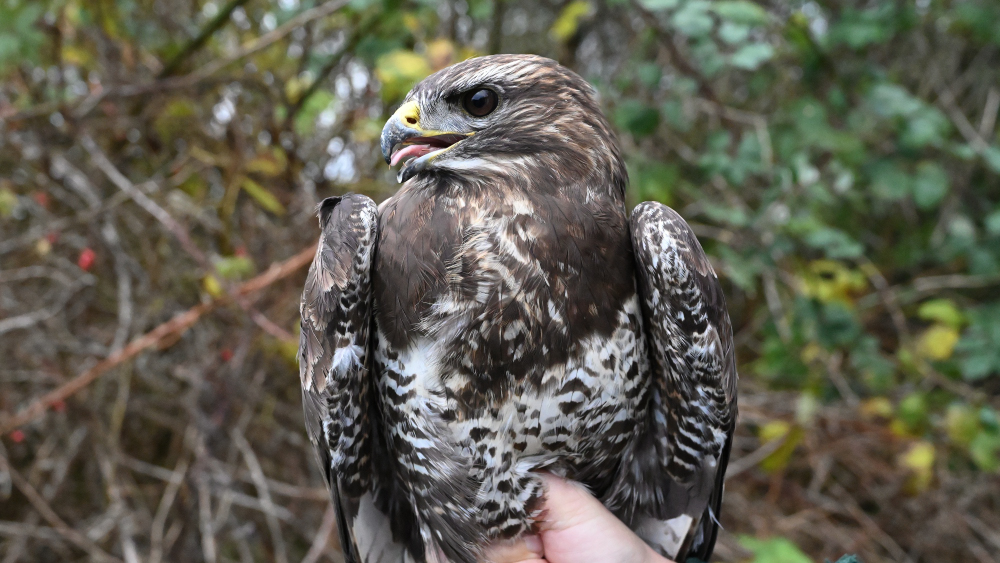
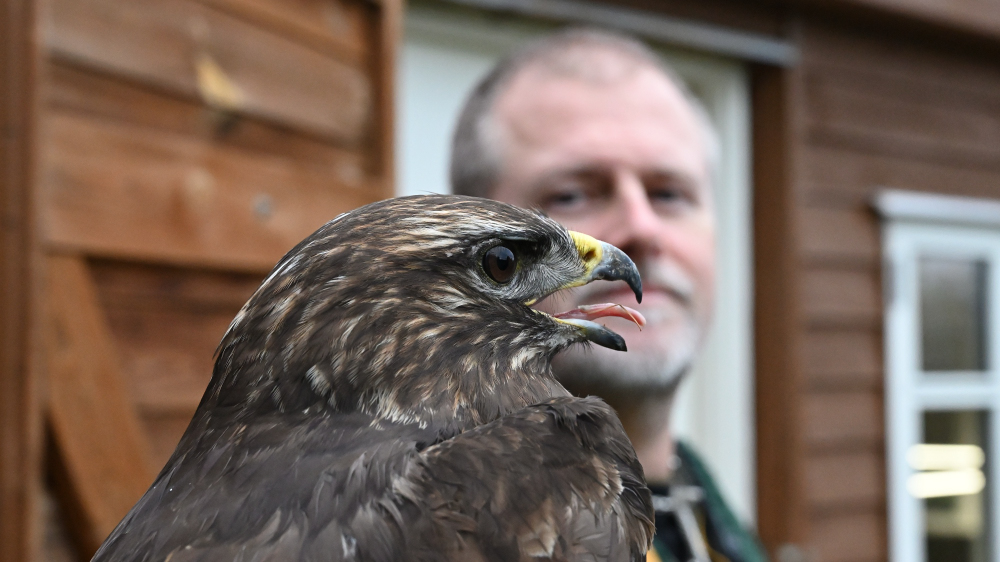
I november 2019 røg samme Musvågen i en fælde på engen ved fuglestationen, men nåede at undslippe, før de to ringmærkere Gail Stride og Ramón Soto Madrid kun nå at løbe hen til fælden. Et kvarter senere var Gail på vej ud for at løbe en tur, da hun så, at Musvågen var i fælden igen. Denne gang lykkedes det for Ramon og Hans Lind at få fat i den. Gail satte ring på Musvågen, og de vejede den på en køkkenvægt til 1.152 gram. Den blev ikke kønsbestemt. Hanner af Musvåger er i gennemsnit lidt mindre end hunner, men ellers er der ingen synlige forskelle.
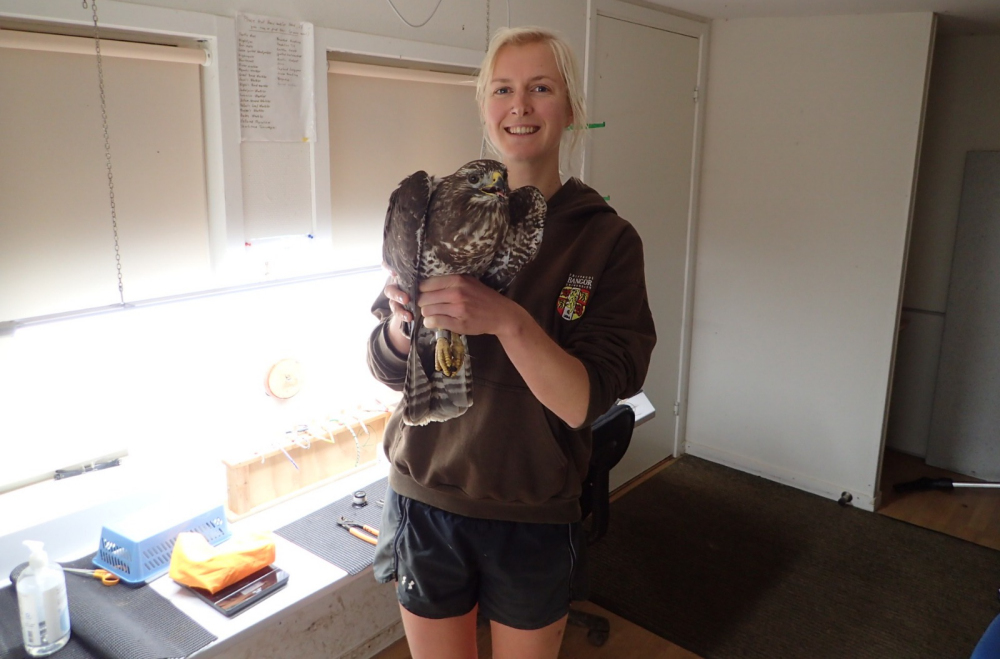
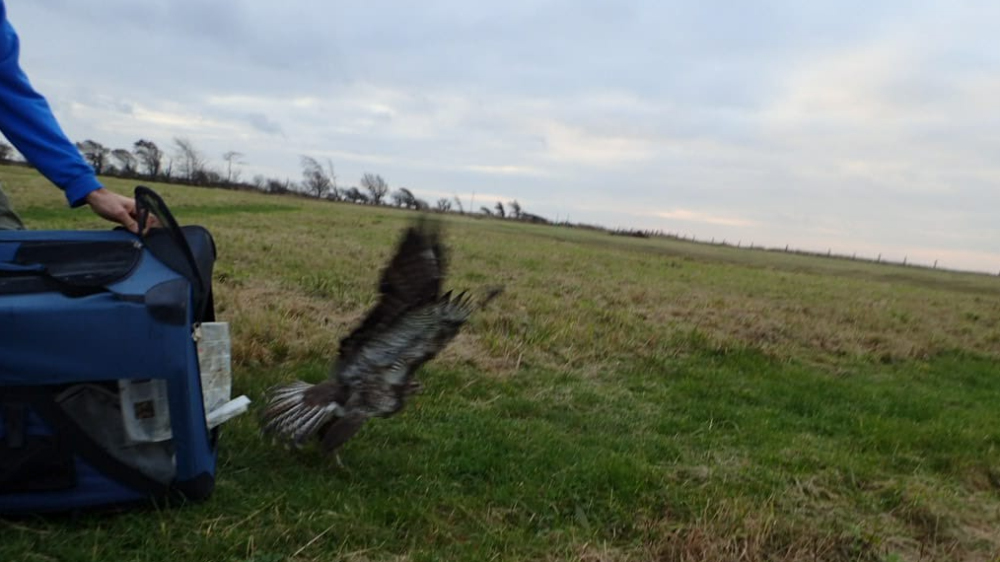
I 2019 blev Musvågen fanget så sent på eftermiddagen, at Gail og Ramon besluttede at vente til næste morgen med at slippe den ud i friheden igen.
Sidste år så vi en tilsvarende ringmærket mørk Musvåge ved fælden på engen, men antog, at det måtte være en af de to unge Musvåger, som blev ringmærket på stationen i efteråret 2022. Den gik imidlertid ikke i fælden, så det forblev et mysterium, hvilken af de to Musvåger det var.
Nu er mysteriet så opklaret: Det var ingen af de to fra 2022, men den, som Gail og Ramon fangede i 2019.
En tilsvarende mørk Musvåge bliver ofte set i området ved fuglestationen, så vi kan sikkert roligt fastslå, at der er tale om den samme lokale rovfugl gennem alle årene. Der er stor individuel variation i dragterne hos Musvåger, som kan svinge fra næsten helt hvide fugle til meget mørke. Denne Musvåge skiller sig ud ved at være lidt mørkere end gennemsnittet.
Onsdag formiddag vejede Musvågen 1.048 gram. Det var en smule mindre end for fem år siden, men den virkede i øvrigt sund og rask, og vægtforskellen er så lille, at den sagtens kan skyldes et enkelt måltid, og at den er vejet med to forskellige vægte. Vi glæder os til at se den igen ude i landskabet.
Trækket på Odden: Østersøen forekommer snart at være tømt for trækfugle. I Estland så vores kolleger ved Põõsaspea neem onsdag lidt under 2.800 fugle på træk i løbet af syv en halv time, og det var nok samme trend, der gav dagens resultat ved Gedser Odde, hvor det blev til 1.267 fugle af 28 arter. Der er dog stadig noget at glæde sig over – og til. Ved Põõsaspea neem talte de onsdag 108 Dværgmåger (Hydrocoloeus minutus), og dem mangler vi stadig en del af med bare en enkelt forbitrækkende denne onsdag morgen og formiddag.
Vores estiske kolleger så til gengæld ingen Ederfugle (Somateria mollissima), som vi lige har haft et stort ryk af i denne uge, men afstanden på 800 kilometer betyder også, at vi altid er nogle dage ’bagud’. Der kan også være en forskel i, at tusinder af fugle kan ligge på vandet og raste imellem de to lokaliteter, akkurat som vi lige for tiden har 8.000-9.000 Ederfugle liggende på havet ud for Gedser Odde.
Værd at nævne fra onsdagens træk ved Gedser Odde er desuden 175 Rødstrubede Lommer (Gavia stellata). Det viser, at der stadig er gang i lommernes træk, som først topper i begyndelsen af december. De fleste kom i løbet af den første time omkring solopgang. Tidligt på færde var også en adult/voksen han Fjeldvåge (Buteo lagopus) og to Røde Glenter (Milvus milvus), mens en håndfuld andre fortrød ved mødet med vinden, der stadig var hård fra sydvest. Var de kommet en time senere, ville de måske være trukket ud i den da betydeligt svagere vind. Måske ser vi dem igen torsdag.
Se alle dagens observationer i DOFbasen.
Folk på stationen: Hans Lind, Henrik Jørgensen, Ole Friis Larsen
For godt vejr til havtræk
Ringmærkningen: Vinden var lige på kanten, men det gik lige at sætte nettene op.
Dog gjorde vinden at der kom en masse blade i det ene net, så der gik en del tid med at tømme det for blade på runderne. Dog lykkedes det mellem bladene at få 3 gråsiskner(som virkelig mangler i år).
Ved 9 tiden kom Benny forbi med morgenbrød, og han blev helt frem til kl 13.
På trods af vinden var det udmærket med de 4 ringmærkede plus 2 aflæste.
Vinden har lagt sig en del så det ser godt ud for i morgen uden sol og for meget vind. Sol gør at nettene kan ses, og for meget vind kan skade fuglene og er der for meget vind sætter vi aldrig net op.
Dagens ringmærkning og kontroller/Todays ringing and recaptures:
Rødhals/Robin 0(1)
Solsort/Blackbird 0(1)
Sangdrossel/Song thrush 1
Lille gråsisken/Lesser redpoll 3
Total 4(2)
Trækket på Odden: En smuk dag på hele Nordens sydligste punkt. Luften var lun, og det var let at finde læ for den kraftige vind på 10-11 meter i sekundet fra sydvest. Morgenen startede med livlig trafik over havet af især Ederfugle (Somateria mollissima) allerede før solopgang. De fleste dukkede op som små prikker langt ude i det fjerne mod nordøst, så det var nye fugle og ikke rokeringer blandt de flere tusinde rastende Ederfugle ud for Gedser Odde. Også de Rødstrubede Lommer (Gavia stellata) fyldte godt, oven i købet med 47 i en samlet flok, men det hele sluttede temmelig brat, da solen kom op over horisonten og fik magt. Sådan er det ofte med solskin på Odden, det er dejligt vejr til fuglekiggeri og -arbejde, men havets fugle tager en slapper.
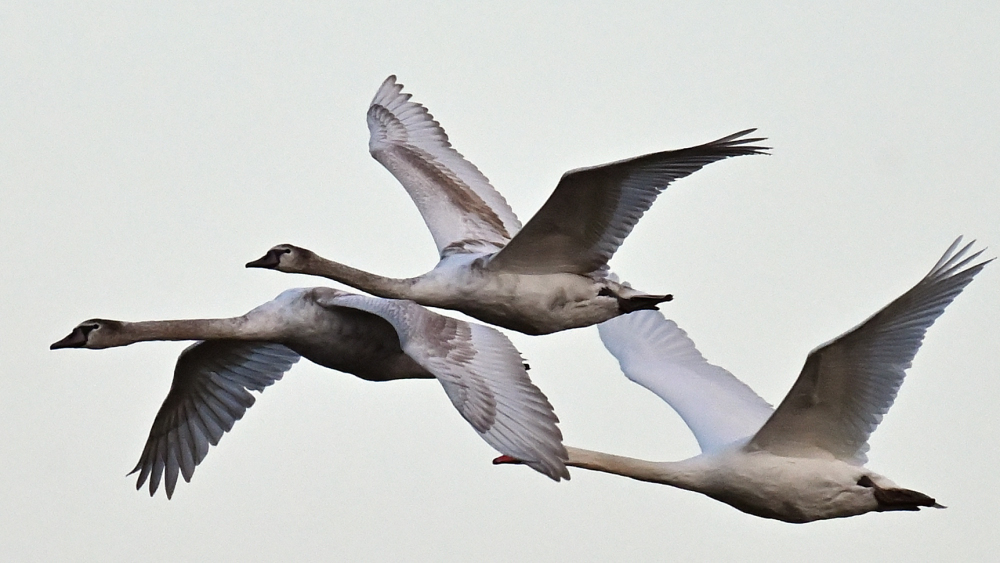
Til gengæld bragte det flotte solskin og den blå himmel lidt rovfugle på banen fra nord med først fire Røde Glenter (Milvus milvus) og siden to Musvåger (Buteo buteo), men vinden var for kraftig. Glenterne nåede helt ud til strandkanten ved p-pladsen, før de vente om og forsvandt mod nord. Musvågerne vendte op et par hundrede meter før, de nåede så langt. Småfugle var der kun få af, men det var fint at opleve en håndfuld Små Korsnæb (Loxia curvirostra) og et par Snespurve (Plectrophenax nivalis) blandt dem, der vovede sig ud over havet i modvinden.
Se alle dagens observationer i DOFbasen.
Folk på stationen: Henrik Jørgensen, Ole Friis Larsen
